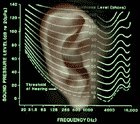



Sound can be measured as a change in pressure when sound waves reach the ear or a measuring device. Sound exposure is usually measured in decibels of sound pressure level (dB SPL), which is a measure of the sound pressure level relative to the lowest hearing threshold of the young, healthy ear set as 0 dB. The scale is logarithmic and a ten-fold increase in the sound pressure level measured corresponds to an increase by 20 dB SPL.
Examples of sound pressure levels (in dB SPL):
The sound pressure of a normal conversation (60 dB) is 100 times greater than that of leaves fluttering (20 dB). Sound pressure of an aircraft taking off nearby (120 dB) is in turn 1000 times greater than that of a normal conversation (60 dB).
Humans can detect low to high-pitched sounds with frequencies ranging from 20 Hz to 20 000 Hz. However, the ear is more sensitive to some frequencies than to others. It is particularly attuned to sounds with frequencies between 3000 and 4000 Hz. Sounds with lower and higher frequencies do not appear as loud. To take into account different sensitivities to different frequencies, a unit of decibel of hearing level (dB HL) has been introduced.
An “A-weighting filter” is commonly used when measuring exposure to sounds in order to emphasize frequencies the human ear is most sensitive to, while attenuating frequencies to which the ear is insensitive. The sound pressure levels measured through this filter are expressed in dB(A) and provides a good indication of the hearing sensation or loudness of different sounds to humans. More...
Each sound has a specific pattern of frequencies which can be detected by the ear or by measuring devices.
To measure the level of exposure to sound in the open field – for instance at work or when listening to music without headphones – a sound meter is placed at the point where the listener would be.
Sounds from headphones are usually measured by artificial ears placed inside a manikin, which represents an average of many torsos and ears of men and women with different anatomies. The sound pressure levels are measured at the eardrum and they are assumed to compare well with real levels.
The sound levels measured by artificial ears must be adjusted to become comparable with measures by sound meters in the open field. Indeed, sound perceived by the human ear depends not only on the sound signal but also on factors such as the shape of the torso, the clothing, the hair style, head shape, size and shape of the ear and the inside of the ear, the characteristics of the eardrum and distortion due to other listeners or objects in the room.
Based on the sound pressure measurements it is possible to establish:

This summary is free and ad-free, as is all of our content. You can help us remain free and independant as well as to develop new ways to communicate science by becoming a Patron!